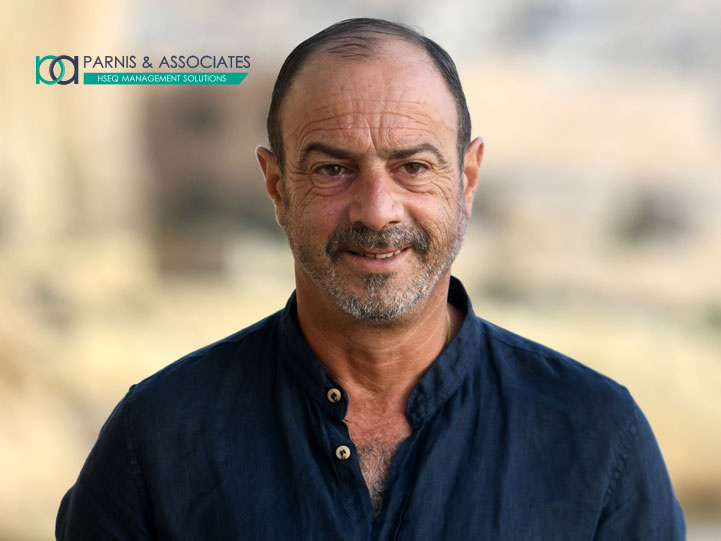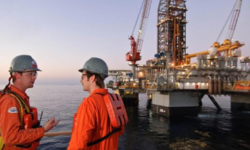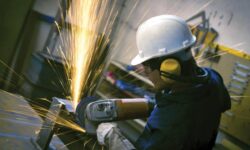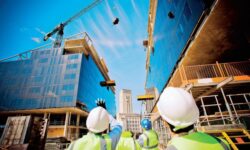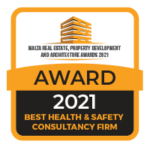INTERVIEW WITH PATRICK PARNIS
We catch up with Patrick Parnis, a successful skilled Health and Safety consultant with over twenty years of experience in HSEQ Management. He speaks to us about the importance of implementation of high-level health, safety, environmental and quality management systems in every industry.
Patrick Parnis took home Best Health & Safety Consulting Firm of the Year, Best Health & Safety Professional of the Year and the Lifetime Achievement Award at Malta's Real Estate, Development & Architecture Awards 2021.
HOW LONG HAVE YOU WORKED IN THE HEALTH AND SAFETY INDUSTRY?
After over twenty-four years in compliance management, I joined Merit/Methode Electronics in 1997 as Quality Management Facilitator. My responsibilities included the implementation and maintenance of International Management Systems ISO9001, QS9000, TS16949 and ISO14001 Standards. Meanwhile, I had to focus on the Health & Safety Management Systems when I joined VAOS Ltd. This was a multinational oilfield services company with over 1000 employees and was heavily involved in the construction and maintenance of the Libyan Oil & Gas Infrastructure. For 12 years, I led the company through the implementation and certification programs of ISO 9001 and OHSAS 18001 Management Systems Standards.
Due to the civil war in Libya, I returned to Malta in 2014 where I set up my own consultancy company Parnis & Associates Ltd (P&A). My initial Health and Safety Consultant services in Malta started in the construction industry, supervising multiple project sites. Other industries followed and I am now involved in various Health & Safety jobs from Energy, Film Productions and Events.
DO YOU SPECIALISE IN ANY PARTICULAR ASPECTS OF HEALTH AND SAFETY?
I started my technical career as an apprentice at the Malta Shipbuilding Co. Ltd which exposed me to Heavy Industry Projects from an early age for 7 years. When I joined Methode Electronics, I continued my studies and intensified my development on ISO Management Systems. Here I had exposure to high precision engineering processes, working in a fast-changing environment and demanding automotive industry.
Implementing Management Systems involves the following:
- development of policies and procedures,
- communication and awareness,
- training of employees,
- auditing and monitoring of processes and facilities,
- and conducting regular management reviews completing the Plan-Do-Check-Act Cycle.
Today, I am very much involved in the construction and film industry. This requires me to spend a great amount of time monitoring safety at construction sites or at a filming location.
I enjoy both aspects. This job allows me to be the officer monitoring and enforcing safety on the shop-floor, construction site or film set. I can also be the Executive at the office developing protocols and documents, auditing and monitoring company-level key performance indicators.

CAN YOU TELL US MORE ABOUT THE SERVICES YOU OFFER?
P&A provides a complete range of HSEQ Management Systems Advisory Services ranging from:
HSEQ Management Systems Advisory Services (ISO / Local / Industry Specific)
This service is for any company that has the interest to start a continuous improvement program by standardising their operations. Our Health and Safety Consultant services begin with a Gap Analysis. This identifies the existing level of compliance against the local or International Standard Requirements. Then, we help companies develop new processes or improve existing ones to the required standard. In general, we manage and lead our clients through the whole journey of ISO Certification.
Risk Assessments
Risk Assessments are a legal demand for Employers. As a result, the employer is responsible for finding any risks generated by their processes, facilities and operations in general. Additionally, an employer also needs to implement the necessary control measures to reduce the risk as low as reasonably practical. A company needs to perform a Risk Assessment when there are new changes
- in processes,
- machinery and equipment,
- material and surrounding environment.
It is one of the key requirements for implementing effective Health & Safety Management systems.
Inspections & Audits
Audits are part of the appraisal process for Management Systems. P&A offers internal and second-party auditors for those companies that prefer independent auditors looking into their documented management system and operations. Auditors interview management and employees, review documents and observe activities. After that, an audit report is given to top management highlighting the level of compliance and any improvement opportunities required to the management systems. We generally complete the Audit Cycle with a Follow-up Audit to confirm and verify the implementation of corrective actions.
Emergency Preparedness
Anything we do exposes us to various risks. It is the responsibility of the employer to implement effective emergency protocols at the workplace. This involves:
- the development of Emergency Response Plans to consist of Emergency Response Protocols for Medical,
- Fire and Environmental Emergencies,
- Establishing Emergency Response Team,
- Training of ER Team and conducting regular Emergency Response Drills.
Emergency Preparedness involves the setting up of Fire Protection/Fighting Systems, Signage and Plan Layouts, Emergency lightings systems, First Aid Provisions going into First-Aid Training, Fire Fighting and Chemical Spillage Training as required.
Incident Investigation and Reporting
Incidents are unfortunately considered as the main source of great knowledge and information for safety protection. It is very important that the workplace always reports all incidents. This means everything, from a ‘near miss’, ‘small injury’ up to a ‘fatality’. P&A gives the necessary resources for independent incident investigation and reporting for companies that want to investigate incidents and set up protective measures to eliminate the repetition of events.
HSEQ Training
P&A assists companies in developing their own Health & Safety Training Needs Analysis by developing a Training Matrix. The matrix defines the necessary Health & Safety Training Programs/Sessions required for each role within the organisation, whether it’s the company’s CEO or the shop-floor cleaner. Providing HS Training is a legal requirement and operator licenses for jobs like forklift trucks operators and crane operators are mandatory. The same goes for operatives performing high-risk tasks such as scaffolders etc.
Employers should ensure that operatives have the necessary safety training to operate equipment and machinery. This includes aspects like the need to perform their routine tasks safely preventing injury to themselves, colleagues and the public. On top of that, operatives should also be careful that they do not cause damage to machinery, plant and the environment.
All newly engaged employees should go on an Induction Training & Awareness program. Normally this induction training is given within the first days of employment where the employees are informed about:
- the company policies and procedures,
- operational & facilities hazards,
- do’s and don’ts,
- time and attendance,
- welfare,
- incident reporting and emergency response protocols in general.
P&A provides the necessary guidance to companies ensuring the right approach in provision of Health & Safety Training to its workforce.
Project Supervisor Services
Parnis & Associates provides supervision services in H&S matters at design and construction / execution stage as per LN88/2018 – Work Place (Minimum Health & Safety Requirements for Work at Construction Sites) Regulations. At design stage, P&A will develop a Project Health & Safety Plan addressing the project safety requirements, risk assessments and control measures to be enforced throughout the whole project. Throughout the construction phase, P&A will monitor Health & Safety Practices on site by doing regular visits. We communicate any hazards we note directly with management and/or contractors. Following that we ensure that they tackle any corrective measures that we enforce. We also keep the client notified of each visit with a Site Inspection Report.
HSEQutive (Saas Cloud Base Solution)
One of the reasons why Parnis & Associates has developed this innovative solution is to offer a cloud-based Health & Safety, Environment and Quality Management Systems Platform providing HSEQ professionals with online tools they require to implement the best HSEQ Management practices in their day-to-day operations (www.hsequtive.com)
CAN YOU TELL US IN MORE DETAIL ABOUT THE ROLE OF A SAFETY OFFICER?
The role is to ensure the implementation of Health & Safety Practices in the Workplace. The Safety Officer prepares work in advance when establishing the Top Level Health & Safety Plan. This defines and lays out the Health & Safety policies and procedures at the workplace. After that the operatives receive the Health & Safety Plan in the form of training sessions or toolbox talks on site. Additionally, all subcontractors working on the project also receive this. Apart from the Health & Safety Plan, the Safety Officer is involved in the development and review of Risk Assessments.
The Safety Officer ensures that the necessary resources and control measures listed in the H&S Plan and Risk Assessments are effectively implemented at the workplace. H&S Officers review method statements and operating instructions to familiarise themselves better with the work plans. From there they also observe ongoing works to ensure operations are carried out safely and in a planned, coordinated manner.
Emergency Response Planning & The Safety Officer
Emergency Response Planning is also part of the Health & Safety Officer Responsibilities. The risk assessment exercise identifies the major hazards and risks, and relevant control measures. This assists in defining emergency response requirements. In general, every workplace needs to have a basic First Aid Box as a minimum, and adequate Fire Protection Systems. The Safety Officer ensures that there is an emergency response plan layout and that all employees know about it. Such layouts will also be in common areas for all workers to see. The layout shall provide safe route directions leading workers towards the nearest assembly point, and marking the locations of fire extinguishing equipment, first aid box and emergency equipment, and spill kit location.
The Safety Officer also leads the Emergency Response Team who will be acting specific tasks and duties in case of an emergency situation. An emergency drill tests the Emergency Response Plans and Teams regularly. During this test, employees familiarise themselves with emergency protocols and identify any failures/malfunctions and other emergency response improvements. We do this through the simulation of emergency situations.
The safety officer is also responsible for investigating and reporting of incidents at the workplace. The safety officer will carry out investigations at the site of the incident, interview injured persons and other witnesses. He/she will also look into machinery maintenance records, operator training records and other process-related documentation. Based on his/her investigation, the safety officer will identify the root cause of the incident and recommend the necessary corrective and preventive measures to eliminate the recurrence of a similar incident.
WHAT ARE THE MISCONCEPTIONS ABOUT HEALTH AND SAFETY IN THE CONSTRUCTION INDUSTRY?
The first common misconception is that people think that the OHSA in Malta is inexistent and not effective enough in its regulatory and enforcement obligations. Let me assure you that with its very limited resources OHSA is giving its best possible attention to the construction industry. They have a shortage of personnel and I strongly believe that this is where OHSA needs technology to be able to cover 2000+ construction sites yearly.
The second misconception is that ALL developers are greedy and do not care for the health & safety of their workers. Reality shows that there is a greater amount of unsafe contractors than those who consider Health & Safety seriously and provides the necessary resources to comply to requirements. I believe this misconception of ‘ALL Developers are greedy’ is a very unfair statement on those contractors who are truly diligent and complaint.
Industry Contractor HS Audits and Contractor Safety Performance Classification Systems can be the way forward to evaluate the level of Safety of Contractors.
WHAT ARE THE BIGGEST CHALLENGES YOU FACE IN YOUR ROLE?
We face various safety challenges in the construction industry. The latest and most worrying issue is that of ‘communication’ and ‘introduction of new unsafe practices’ at construction sites. We have seen a drastic influx of foreign workers in the construction industry bringing in a lot of challenges for the locals and foreigners alike especially in communication. This for me is very concerning especially if one needs to communicate any special safety measures for the task at hand.
Another related challenge we also face is the fact that foreigners are bringing in their own method of working. This may not always be considered as safe on this side of the world. We witness a great amount of imaginative makeshift platforms and stages that are unsafe. We also see people working without giving any protection or respect to the public. These are all attributed to the lack of control of professionals in the Construction Industry. BICC’s Skill Card can play a great role in the regularization of Contractors, Self Employed and Professionals. However, same with OHSA department, the resources are limited to control the overwhelming growth of the construction industry.
I trust that the new Building and Construction Agency – BCA will eventually deploy the desperately needed contractor regularization in the Construction Industry.
WHERE DO YOU THINK MOST CONTRACTORS FALL SHORT IN TERMS OF HEALTH AND SAFETY?
I believe that some contractors lack health & safety practices due to some old attitudes stating that safety is only creating additional costs and hindering work progress. These are very limited in number but are somehow considered as a high risk.
Contractors must take Safety into account at quotation and budgeting phase. Missing this consideration out from project budget will only give way to some ‘surprise’ costs. Sensible contractors always budget for safety and ensure safety costs are effectively in use on site.
I also believe that there is a lack of general construction safety training programmes. We attribute this lack of general training to the mentality of loss of production and an additional cost.
We are also still facing the old village mason who on alterations in old, traditional, unsafe ways. The industry is now phasing out these people. Still, they must realise that everyone should adhere to safety at all times.
I believe that businesses fall short of health and safety because they are only focusing on their core business activity – producing and selling their product – forgetting the safety aspect of their operations.
Article courtesy of Mediatoday Co. Ltd which was published on the Architecture & Design Magazine.

